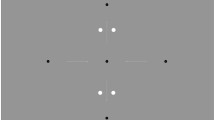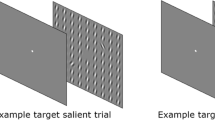Abstract
The retinal positions of objects in the world change with each eye movement, but we seem to have little trouble keeping track of spatial information from one fixation to the next. We examined the role of attention in trans-saccadic localization by asking participants to localize targets while performing an attentionally demanding secondary task. In the first experiment, attentional load decreased localization precision for a remembered target, but only when a saccade intervened between target presentation and report. We then repeated the experiment and included a salient landmark that shifted on half the trials. The shifting landmark had a larger effect on localization under high load, indicating that observers rely more on landmarks to make localization judgments under high than under low attentional load. The results suggest that attention facilitates trans-saccadic localization judgments based on spatial updating of gaze-centered coordinates when visual landmarks are not available. The availability of reliable landmarks (present in most natural circumstances) can compensate for the effects of scarce attentional resources on trans-saccadic localization.





Similar content being viewed by others
References
Awh E, Jonides J (2001) Overlapping mechanisms of attention and spatial working memory. Trends Cogn Sci 5:119–126
Awh E, Jonides J, Reuter-Lorenz PA (1998) Rehearsal in spatial working memory. J Exp Psych Hum Percept Perform 24:780–790
Batista AP, Buneo CA, Snyder LH, Andersen RA (1999) Reach plans in eye-centered coordinates. Science 285:257–260
Bisley J, Goldberg ME (2003) Neuronal activity in the lateral intraparietal area and spatial attention. Science 299:81–86
Brainard DH (1997) The psychophysics toolbox. Spat Vis 10:433–436
Buneo CA, Jarvis MR, Batista AP, Andersen RA (2002) Direct visuomotor transformations for reaching. Nature 416:632–636
Burr DC, Morrone MC (2013) Constructing stable maps of the world. Perception 41:1355–1372
Cai RH, Pouget A, Schlag-Rey M, Schlag J (1997) Perceived geometrical relationships affected by eye-movement signals. Nature 386:601–604
Cavanagh P, Hunt AR, Afraz A, Rolfs M (2010) Visual stability based on remapping of attention pointers. Trends Cogn Sci 14:147–153
Coello Y, Grealy M (1997) Effect of size and frame of visual field on the accuracy of an aiming movement. Perception 26:287–300
Conti PD, Beaubaton D (1980) Role of structured visual field and visual reafference in accuracy of pointing movements. Percept Mot Skills 50:239–244
Crespi S, Biagi L, d’Avossa G, Burr DC, Tosetti M, Morrone MC (2011) Spatiotopic coding of BOLD signal in human visual cortex depends on spatial attention. PLoS ONE 6(7):e21661. doi:10.1371/journal.pone.0021661
d’Avossa G, Tosetti M, Crespi S, Biagi L, Burr DC, Morrone MC (2007) Spatiotopic selectivity of BOLD responses to visual motion in human area MT. Nat Neurosci 10:249–255
Deubel H (2004) Localization of targets across saccades: role of landmark objects. Vis Cogn 11:173–202
Deubel H, Schneider WX, Bridgeman B (1996) Postsaccadic target blanking prevents saccadic suppression of image displacement. Vis Res 36:985–996
Duhamel JR, Colby CL, Goldberg ME (1992) The updating of the representation of visual space in parietal cortex by intended eye movements. Science 255:90–92
Gardner JL, Merriam EP, Movshon JA, Heeger DJ (2008) Maps of visual space in human occipital cortex are retinotopic, not spatiotopic. J Neurosci 28:3988–3999
Goldberg ME, Bisley J, Powell KD, Gottlieb J, Kusonoki M (2002) The role of the lateral intraparietal area of the monkey in the generation of visual saccades and visuospatial attention. Ann N Y Acad Sci 956:205–215
Golomb JD, Kanwisher N (2012a) Higher level visual cortex represents retinotopic, not spatiotopic, object location. Cereb Cortex 22:2794–2810
Golomb JD, Kanwisher N (2012b) Retinotopic memory is more precise than spatiotopic memory. Proc Natl Acad Sci 109:1796–1801
Golomb JD, Chun MM, Mazer JA (2008) The native coordinate system of spatial attention is retinotopic. J Neurosci 28(42):10654–10662
Gottlieb J, Kusonoki M, Goldberg M (1998) The representation of visual salience in monkey parietal cortex. Nature 391:481–484
Hoffman JE, Subramaniam B (1995) The role of visual attention in saccadic eye movements. Percept Psychophys 57:787–795
Hunt AR, Cavanagh P (2009) The perceived direction of gaze shifts before the eyes move. J Vis 9:1–7
Hunt AR, Cavanagh P (2011) Remapped visual masking. J Vis 11:1–8
Irwin DE, Yantis S, Jonides J (1983) Evidence against visual integration across saccadic eye movements. Percept Psychophys 34:49–57
Jonikaitis D, Szinte M, Rolfs M, Cavanagh P (2013) Allocation of attention across saccades. J Neurophysiol 109:1425–1434
Knapen T, Rolfs M, Cavanagh P (2009) The reference frame of the motion aftereffect is retinotopic. J Vis 9:1–6
Krigolson O, Heath M (2004) Background visual cues and memory-guided reaching. Hum Mov Sci 23:861–877
Krigolson O, Clark N, Heath M, Binsted G (2007) The proximity of visual landmarks impacts reaching performance. Spat Vis 20:317–336
Lemay M, Bertram BM, Stelmach GE (2004) Pointing to an allocentric and egocentric remembered target. Mot Control 8:16–32
Mathôt S, Theeuwes J (2011) Visual attention and stability. Philos Trans R Soc Lond B Biol Sci 366:516–527
McKyton A, Zohary E (2007) Beyond retinotopic mapping: the spatial representation of objects in the human lateral occipital complex. Cereb Cortex 17:1164–1172
McKyton A, Pertzov Y, Zohary E (2009) Pattern matching is assessed in retinotopic coordinates. J Vis 9:1–10
Melcher DE (2005) Accumulation and persistence of memory for natural scenes. J Vis 6:8–17
Melcher DE, Colby CL (2008) Trans-saccadic perception. Trends Cogn Sci 12:466–476
Melcher D, Morrone MC (2003) Spatiotopic temporal integration of visual motion across saccadic eye movements. Nat Neurosci 6:877–881
Pearson D, Sahraie A (2003) Oculomotor control and the maintenance of spatially and temporally distributed events in visuo-spatial working memory. Q J Exp Psychol 56:1089–1111
Radvansky GA, Carlson-Radvansky LA, Irwin DE (1995) Uncertainty in estimating distances from memory. Mem Cognit 23:596–606
Rolfs M, Jonikaitis D, Deubel H, Cavanagh P (2011) Predictive remapping of attention across eye movements. Nat Neurosci 14:252–256
Schütz I, Henriques DYP, Fiehler K (2013) Gaze-centered spatial updating in delayed reaching even in the presence of landmarks. Vis Res 87:46–52
Sheth BR, Shimojo S (2004) Extrinsic cues suppress the encoding of intrinsic cues. J Cogn Neurosci 16:339–350
Wenderoth P, Wiese M (2008) Retinotopic encoding of the direction aftereffect. Vis Res 48:1949–1954
Wurtz RH (2008) Neuronal mechanisms of visual stability. Vis Res 48:2070–2089
Acknowledgments
This research was supported by Grants from the BBSRC (BB/H01280X/1) and the James S McDonnell Foundation (both to A.R.H). The authors would like to thank Kelly Norman for assistance with data collection, and the members of the Perception and Attention theme at the University of Aberdeen for feedback and discussion.
Author information
Authors and Affiliations
Corresponding author
Rights and permissions
About this article
Cite this article
MacInnes, W.J., Hunt, A.R. Attentional load interferes with target localization across saccades. Exp Brain Res 232, 3737–3748 (2014). https://doi.org/10.1007/s00221-014-4062-2
Received:
Accepted:
Published:
Issue Date:
DOI: https://doi.org/10.1007/s00221-014-4062-2




